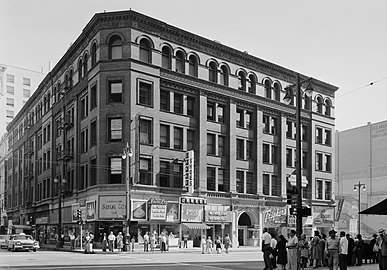Template:Buildings along Broadway from Temple to 3rd streets
-
1905 view south on Broadway from north of Temple Street. The Times Mirror printing house in foreground, marked 110 N. Broadway, now site of the Hall of Justice. Towers of the 1888 City Hall on the 200 block of S. Broadway in the distance. Fort Moore Hill, now leveled, at right.
-
c.1893–1900, looking east along Third St. from Olive St. on Bunker Hill. 3 buildings stand out from left to right: the 1888 City Hall (Broadway between 2nd/3rd), the Stimson Block (3rd & Spring), and the Bradbury Building (3rd & Broadway)
Temple and Broadway
[edit]Cable cars of the Temple Street Cable Railway ran along Temple Street starting in 1886 and were replaced with Pacific Electric streetcars in 1902.[1][2]
Northwest corner of Temple and Broadway
[edit]
-
The Women's Christian Temperance Union Temple and a Temple Street Cable Railway car, 1890
- The three-story brick Women's Christian Temperance Union building was erected in 1888 for $45,000.[3] Also known as the Temperance Temple, it has been demolished[4] and was replaced in 1957 by the Los Angeles County Central Heating and Refrigeration Plant.[5]
Southeast corner of Temple and Broadway (Pound Cake Hill, west side of New High St.)
[edit]
-
Los Angeles High School
on Pound Cake Hill, 1870s -
"Red Stone" Courthouse and Post Office (1891-1936)
-
Hall of Records, adjacent to Courthouse on the south (1911–1973)
-
Clara Shortridge Foltz courthouse on the site today
This location was at the time known as Pound Cake Hill. The buildings located here faced New High Street to their east and Broadway to their west. They were as follows:[6]
- Los Angeles High School, whose original location (1873-1887) was between New High on the west and Broadway on the east, south of Temple Street. It was moved to California and Sand streets, and in 1890 a new facility was built on Fort Moore Hill, immediately north of where Broadway today crosses the Hollywood Freeway. The Pound Cake Hill school was demolished and replaced by:
- First, the Red Stone Courthouse (or "Red Sandstone Courthouse"), which took over the function of courthouse from the Clocktower Courthouse (also called the Temple Courthouse). It was damaged beyond repair by Long Beach earthquake of 1933 and was torn down in 1936.
- The Los Angeles County Hall of Records was built next to (south of) the Red Sandstone Courthouse in 1911, After the 1971 San Fernando earthquake, it was determined to be unsafe and it was demolished in 1973. A new Hall of Records was built and opened in 1962, one block west on the south side of Temple between Broadway and Hill.
Currently on the site are:
- Clara Shortridge Foltz Criminal Justice Center (Los Angeles County Grand Jury), originally known as the Criminal Courts Building, opened in 1972
- A portion of Grand Park, which stretches mid-block between Temple and First, from City Hall at Spring Street, to the Music Center at Grand Avenue.
Realignment of Spring Street (1925)
[edit]The Poundcake Hill buildings originally backed up to Broadway to their west, and faced New High Street to their east. New High Street (see Sanborn map above) was a north-south street that ran parallel to Broadway, and to Spring Street to its east. As part of the construction of City Hall in the early 1920s, New High Street was removed south of Temple, and Spring Street was realigned more towards a north-south orientation, parallel with Broadway, instead of running more northeasterly and meeting Main Street at Temple Street. As a result the Poundcake Hill buildings faced the newly aligned Spring Street until they were demolished.
Southwest corner of Temple and Broadway
[edit]- The second location of the Los Angeles County Hall of Records, opened 1962.
Adjacent to the south, mid-block, is a portion of Grand Park.
First and Broadway
[edit]-
Looking south along Broadway from First Street, 1904-5. At right, from left to right: C.H. Frost Building (#145), 141-3, the turreted Roanoke Bldg (#137-9), Newell & Gammon Bldg. (#131-5), Mason Opera House (#125-9)At left Chamber of Commerce (#128), 1888 City Hall (#228-238).
Northeast corner of First and Broadway
[edit]-
1886 Los Angeles Times Building
- Los Angeles Times 1886 building. This building was razed after a 1910 bombing and a new headquarters was opened on this site in 1912. The newspaper later moved further south on Spring Street to the Los Angeles Times building, now part of Times Mirror Square, occupying the entire block between Broadway, Spring, First and Second streets.[7]
Northwest corner of First and Broadway
[edit]
- Site of the Tajo Building (1896–mid-20th c.).[8] Now the location of the Los Angeles County Law Library.[9]
Southeast corner of First and Broadway and east side of 100 block
[edit]-
1973 Pereira Addition building, Times Mirror Square
-
1900s view of Chamber of Commerce, 128 S. Broadway
-
Postcard c.1910 of Chamber of Commerce, 128 S. Broadway
- Site of the Culver Block retail and office building.[10] Now the site of the Times Mirror Square 1973 Pereira Addition, so called because it was designed by William Pereira.
- South of the Culver Block was the Los Angeles Chamber of Commerce building, 128–130 S. Broadway, opened February 12, 1904,[11] a landmark at the time featured on postcards and in books. 6 stories, 4 floors. Ground floor offices included those of the Los Angeles Herald and Consolidated Bank.[12]
Southwest corner of First and Broadway
[edit]
-
Mason Opera House or Mason Theatre
-
C.H. Frost Building at 145 S. Broadway, c.1904-5. To its right, the turreted Roanoke Bldg. (#137-9), Newell & Gammon Bldg. (#131-5), and the Mason Opera House (#125-9).
The southwest corner, during Victorian times the site of unremarkable retail and office buildings, was from 1958 the location of the State Office Building, (1958-60, architect Anson C. Boyd, razed 2006). It was named the Junipero Serra State Office Building, and this moniker would be transferred to the former Broadway Department Store building at 4th and Broadway when it was opened to replace this building in 1998.[13] It is now the location of the New U.S. Courthouse built in 2016, taking up the entire block between Broadway, Hill, First and Second.[14]
Just south of the southwest corner was the Mason Theatre, 127 S. Broadway. Opened in 1903 as the Mason Opera House, 1,600 seats. Benjamin Marshall of the Chicago firm Marshall & Wilson designed the building in association with John Parkinson. Marshall is known for designing the Iroquois Theatre in Chicago. Remodeled in 1924 by Meyer & Holler. Later, as the Mason Theatre, it showed Spanish-language films. Demolished 1955.[15]
145 S. Broadway,[16]site of the C. H. Frost Building, later known as the Haig M. Prince Building. Built 1898, architect John Parkinson,[17] Now the location of the new United States Courthouse built in 2016, taking up the entire block between Broadway, Hill, First and Second.[14]
Second and Broadway
[edit]-
Broadway looking south from 2nd St., 1895-1905. The 1888 City Hall is visible on the left (east) side.
-
Another view of Broadway looking south from 2nd St. showing a cable car, c.1893-1895
Northeast corner of Second and Broadway
[edit]
-
The 2nd & Broadway Hellman Building in 1918
One of several “Hellman Buildings” across Downtown L.A. — not to be confused with the still-existing Hellman Building at Fourth and Spring — was located here (#138) from 1897 to 1959.[18] The site is now a parking structure, part of the Times Mirror Square complex.
Southwest corner of Second and Broadway and the west side of the 200 block
[edit]
-
West side of Broadway from #229 (at left) to #207 (at right, SW corner of 2nd St.) sometime after 1894. From left to right: Bicknell Block with the Los Angeles Furniture Co.; Potomac Block with Ville de Paris and City of London stores, the YMCA building with its turret and two gables, and the American National Bank building.
-
American National Bank (later California Bank) Building (1878-1911), southwest corner, 1890. To the viewer's left (south) are the turret and two gables of the YMCA Building (1889), then the Potomac Block (1890).
-
Merchants Trust Company Building in 1910
-
Potomac Block c.1890-1895.
-
The Ville de Paris department store, 1901
-
Boston Dry Goods and Harris Newmark buildings, 1899
The west side of the 200 block of South Broadway had a key place in the retail history of Los Angeles from the 1893 through 1917, as it was home to several prominent early department stores such as the Ville de Paris, Coulter's department store from 1905–1917, and J. W. Robinson's "Boston Dry Goods" store from 1895–1915. All three stores would move to Seventh Street when it became the upscale shopping street between 1915 and 1917.
- On the southwest corner of 2nd and Broadway was Judge O'Melveny's house, built in 1870. This was replaced by the American National Bank (later California Bank) Building, which one turn was replaced by the California Building in 1911. Nos. 201-213 Broadway are now known named the Broadway Media Center.
Further south on the west side of Broadway, was 207–211, location of the:
- YMCA Building (#207–209–211), Romanesque Revival architecture, opened in July 1889, demolished in 1903.
- The YMCA operated here at #207 from 1889 until 1903,
- City of London opened here in August 1891, run by Messrs. Hiles and Niccolls, who came from the City of Paris department store. It carried curtains, window shades, comforters, and the like.[19] It operated here until August 1895, when it moved next door to the Potomac Block at #213.[20]
The YMCA Building was demolished to make way for the:
- Merchants Trust Co. Building.[21]
Coulter's complex: Potomac and Bicknell blocks
[edit]The adjacent Potomac Block and Bicknell Block originally housed prominent retailers of the day, then were joined together in 1906 by Coulter's department store to form a complex, opening it as a new, 157,000 sq ft (14,600 m2) store in June, 1905.[22][23][24]
Potomac Block
[edit]The Potomac Block, 213–223 S. Broadway, was from 1905 to 1917 known as the B. F. Coulter Building. It was originally developed by lumberyard and mill owner J. M. Griffith. It was designed in 1888 by Block, Curlett and Eisen in Romanesque architectural style[25] and opened on July 17, 1890.[26]
Tenants included:
- Ville de Paris department store (at 221–223, from 1893 through 1906),[25]
- City of London Dry Goods Co., which moved here from next door at #211 in August 1895 and advertised for this location through August 1899.[20]
It was the first time major retail stores opened on South Broadway, in what would be a shift of the upmarket shopping district from 1890 to 1905 from around First and Spring to South Broadway. In 1904, Coulter's bought the Potomac Block, and combined it with the Bicknell block to create its new store that opened in 1905.
After Coulter's moved:
- 215 continued as a branch of Coulter's through 1927. Then, 215–217 was home to the Pacific Furniture House in the 1940s.
- 219 housed Fisch's Department Store in the 1940s.
The building was demolished in 1953 and is still the site of a parking lot.[27]
Bicknell Block
[edit]The Bicknell Block (or Bicknell Building) at 225–229 S. Broadway, with back entrances at 224–228 S. Hill Street. was part of Coulter's from 1905 from 1917. After Coulter's moved in 1917, it housed the Western Shoe Co. (through 1922), later known as the Western Department Store (1922–1928). Lettering covered the face of the building from top to bottom through the end of the 1950s: "THE LARGEST SHOE DEPT. IN THE WEST".[28]
Further south on Broadway
[edit]- 231-235, the Harris Newmark Building (1899, Abram Edelman), Bartlett Music Co. (#233), annex to J. W. Robinson's (#235); Goodwill Industries store (#233-235, 1950s–60s). The building still stands, but all floors except the ground floor have been removed.
- 237-241, the Boston Dry Goods Building (completed 1895, demolished, architects Theodore Eisen and Sumner Hunt, designer of the Bradbury Building)[29][30] The building was home to J. W. Robinson's "Boston Dry Goods" store from 1895 to 1915, Scott's Department Store (239–241, 1920s), Third Street Store (237–241, 1950s–60s). Demolished, currently the site of a parking lot.
- 251 was home to the I. Magnin speciality department store, which opened here on January 2, 1899;[31] starting 1904, I. Magnin announced that the store would be known by the name of its manager, Myer Siegel.[32]
Southeast corner and east side of Broadway from 2nd to 3rd
[edit]
-
Looking north along Broadway at its east side past 2nd Street. From top left: The L.A. Times Bldg. with castle-like turret, with the 1911 Hall of Records behind it. The Chamber of Commerce Bldg. at #128. Drugstore in the Hellman Bldg. (#144–6) at the NE corner of 2nd Street. Dentist in the Nolan, Smith and Bridge Bldg. (#200–4) at the SE corner of 2nd. New King Hotel in the Gordon Bldg. (#206–10). Victor Clothing in its location from 1926 to 1964 in the Crocker Bldg. (#212–6). Pig 'n Whistle in the Copp Bldg. (#218–224). 1888 City Hall at far right
-
Los Angeles City Hall (1888–1928, demolished)
-
B'nai B'rith Temple (opened 1873), the city's first synagogue
-
Victor Clothing building, #242
The southeast corner of 2nd and Broadway was the site of
- The First Presbyterian Church was located here in 1894.[33] The church was replaced sometime before 1906 by the:
- Nolan, Smith and Bridge Building, #200-4 S. Broadway, stores and a restaurant.[34]
- Now the corner is the site of the Historic Broadway underground light rail station.
Mid-block were:
- Crocker Building, #212–6[35] Home to Victor Clothing from 1920 to 1964
- B'nai B'rith Temple (1873), 214 S. Broadway (post-1890 numbering), the city's first synagogue, razed to make way for the Copp Building, 218–224 S. Broadway, home to the original (1908) Pig 'n Whistle candy shop and tea room.[36] The Pig 'n Whistle would open locations at 7th and Broadway and in Hollywood, where it would become a landmark restaurant that still operates today.
- City Hall (1888–1928; opened 1888, demolished 1929; 228–238 S. Broadway, architect Solomon Irmscher Haas, Romanesque Revival). Now a parking lot. Three stories, it had a 150-foot (46 m) campanile. Red and brown brick. Housed the Los Angeles Public Library for a time until it moved to the new Hamburger's department store building at Eighth and Broadway in 1908.[37] The site is now part of the "(213) S. Spring" parking garage.[9]
- #240-246 the Hosfield Building, location of the Natatorium (indoor swimming pool) in 1894 and the Imperial Restaurant in 1906.[35] After 1964, location of Victor Clothing, notable for its changing murals reflecting local Chicano culture. Victor Clothing operated here until 2001, and was known i.a. for its frequent ads on Spanish-language television.[38]
Third and Broadway
[edit]Northwest corner of Third and Broadway
[edit]
-
Pan American Lofts (built 1895)
The corner is home to one of the oldest buildings outside the Plaza area, the 1895 Irvine Byrne Block or Byrne Block; now called the Pan American Lofts. The architect was Sumner Hunt. It was built in a hybrid Spanish Colonial Revival/Beaux-Arts style.
The building was home to the renowned I. Magnin clothing store that opened here on January 2, 1899;[39] on June 19, 1904, I. Magnin announced that the Los Angeles store would henceforth be known as Myer Siegel.[32] After a fire at the Irvine Byrne Building destroyed its store on February 16, 1911, Myer Siegel moved further south on Broadway.
It was modernized and converted to lofts in 2007 and given its present name. The halls and staircase have appeared in many of Alfred Hitchcock's movies, Brad Pitt's Se7en, Fight Club, Blade Runner, and other TV shows and commercials.[40]
From Third Street south to Olympic Blvd. (originally Tenth St.), and from Hill Street east to Los Angeles Street, including Broadway, is the Historic Core district, the city's main commercial and entertainment area in the first half of the 20th century.
Northeast corner of Third and Broadway
[edit]-
East side of Broadway looking south past 3rd St, c.1903-4. From left to right 1888 City Hall (with flag), Rindge Block at NE corner of 3rd, Bradbury Building
-
East side of Broadway looking north past 3rd St, c.1888. From left to right 1888 City Hall (with flag), Rindge Block at NE corner of 3rd, Bradbury Building
On this corner:[41]
- Originally the J. C. Graves house stood here; Graves bought the property in 1879 for $2,250. The house was sold and removed to 10th and Hope streets in 1888.
- Rindge Block (1898, sold in 1899 for $190,000 to Frederick H. Rindge, the "King of Malibu"), 248–260 S. Broadway, commercial building; the top floors were removed and only the ground floor remains.
Southwest corner of Third and Broadway
[edit]-
Entrance area, Million Dollar Theatre
-
Roofline, Million Dollar Theatre
-
Detail, side, Million Dollar Theatre
- Million Dollar Theatre, (1917-8, architects Albert C. Martin and William Lee Woollett, Spanish Baroque Revival style, 2,345 seats), 307 (orig. 301–313) S. Broadway. It is the northernmost of the movie palaces that comprise the Broadway Theater District and is listed in the National Register of Historic Places.[42] Built by Sid Grauman who would later open Grauman's Chinese Theatre in Hollywood. The theater was designed by architects with a fanciful facade in the Churrigueresque style. After more than 30 years as one of the city's most prestigious first-run movie palaces, the Million Dollar Theater presented Spanish-language films and variety shows from 1950 until the late 1980s. The theater had a seating capacity of 2,345 when it opened in 1918.[43]
- Before that, from c. 1895–1917, the Muskegon Block stood on the site,[44] (built c. 1895),[45] named after Muskegon, Michigan where its developer Thomas Douglas Stimson had made his fortune in lumber. From 1905–1917, the Ville de Paris department store was located next door at the Homer Laughlin Building, and the Muskegon Block housed retail tenants such as millinery, men's furnishings, jewelry, piano and music stores,[46] as well as offices.
Southeast corner of Third and Broadway
[edit]-
View from Bunker Hill to Bradbury Building and the Stimson Block at 3rd & Spring. The Pan American Lofts had not yet been built on the NW corner of 3rd & Broadway. Around 1894–5.
-
Bradbury Building in 1894, then anchoring the southwestern end of the business district[47]
-
Bradbury Building in 1960
-
Bradbury Building exterior, 2005
-
Atrium of the Bradbury Building
- Bradbury Building (1893, architects Sumner Hunt and George Wyman, Italian Renaissance Revival, Romanesque Revival, and Chicago School styles), the oldest remaining commercial building in Downtown Los Angeles. The Los Angeles Conservancy calls it an icon and a "unique treasure". Commissioned by gold-mining and real estate millionaire Lewis Bradbury. It is famous for its light-filled atrium, open cage elevators, marble stairways and ornate iron railings, and has appeared in many films including Blade Runner.[43]
- ^ "Map of Temple Street Cable Railway, via Metro (Los Angeles County)".
- ^ "Temple Street Cable Railway (1886)". www.erha.org.
- ^ "New Buildings: A Splendid Showing for the Future Los Angeles". Los Angeles Times. May 13, 1888. p. 3.
- ^ "Water and Power Associates".
- ^ "Los Angeles County Central Heating and Refrigeration Plant". Calisphere.
- ^ "Water and Power Associates". waterandpower.org.
- ^ "Water and Power Associates". waterandpower.org. Retrieved 2021-05-22.
- ^ "PCAD - Tajo Building, Downtown, Los Angeles, CA". pcad.lib.washington.edu.
- ^ a b search for the location, Google Maps, retrieved October 20, 2020
- ^ "Water and Power Associates".
- ^ "BEgins New Era of Achievement: Chamber of Commerce Welcomes Public to Magnificent Home, with Brilliant Reception — Annual Reports Show Splendid Progress". The Los Angeles Times. 1904-02-13. p. 13. Retrieved 2020-11-10.
- ^ "PCAD - Los Angeles Chamber of Commerce Building, Downtown, Los Angeles, CA". pcad.lib.washington.edu.
- ^ "Junipero Serra State Office Building #1", Pacific Coast Architecture Database
- ^ a b "New Los Angeles US Courthouse". www.gsa.gov.
- ^ "Mason Theatre in Los Angeles, CA - Cinema Treasures". cinematreasures.org.
- ^ "2nd Street and Broadway" Huntington Digital Library
- ^ Marques Vickers, Reinventing Broadway, p.52
- ^ "Water and Power Associates".
- ^ "Broadway to the Front". Los Angeles Evening Express. August 7, 1891. p. 8.
- ^ a b "Advertisement for City of Paris". Los Angeles Times. August 6, 1895. p. 10.
- ^ "Merchants Trust Company Building, ca.1910". Calisphere.
- ^ "Great Store for Coulter". Los Angeles Times. August 2, 1904. p. 13.
- ^ "Coulter's location 1906 225–229 S. Broadway and 224-6-8 S. Hill". The Los Angeles Times. 2 November 1906. p. 19.
- ^ "Ad for Coulter's new store opening". Los Angeles Times. May 31, 1905.
- ^ a b "Potomac Block :: Los Angeles Public Library Photo Collection". tessa.lapl.org.
- ^ "Potomac Block. The Work of Building Up a Great City". Los Angeles Herald. July 18, 1890.
- ^ "Potomac Block & Bicknell Block – Romanesque Revival Downtown – PocketSights". pocketsights.com.
- ^ "Western Shoe Company – Western Department Store – 227 S Broadway". Los Angeles Evening Express. 1922-05-26. p. 14. Retrieved 2021-05-22.
- ^ "The Boston Dry Goods Store". Los Angeles Times. 1 January 1895. p. 29. Retrieved 3 May 2019.
- ^ "The New Boston Store:Los Angeles' Finest Commercial Structure Is Complete". Los Angeles Herald. 4 October 1895. p. 5.
- ^ "31 Dec 1898, 4 – Los Angeles Times at Newspapers.com". Newspapers.com.
- ^ a b "19 Jun 1904, 12 – Los Angeles Times at Newspapers.com". Newspapers.com.
- ^ Sanborn Map of Los Angeles: 1894, vol. 1, plate 8, via Library of Congress.
- ^ Sanborn Map of Los Angeles: 1906, vol. 2, plate 131, via Library of Congress.
- ^ a b Sanborn Maps of Los Angeles: 1894, vol. 1, plate 8; 1906, vol. 2, plate 131.
- ^ "Pig 'n Whistle opens 224 S. Broadway". The Los Angeles Times. Dec 10, 1908. p. 22 – via newspapers.com.
- ^ "CityDig: This Was L.A.'s City Hall for 39 Years". Los Angeles Magazine. May 8, 2014. Retrieved 16 May 2019.
- ^ Maese, Kathryn. "The Victor No Longer". Los Angeles Downtown News - The Voice of Downtown Los Angeles. Retrieved 2020-08-11.
- ^ "I Magnin moves from Spring to Broadway 1". Los Angeles Times. Dec 31, 1898. p. 4 – via newspapers.com.
- ^ Flynn, Kathleen Nye. "Mixing the Old With the New". Los Angeles Downtown News – The Voice of Downtown Los Angeles. Retrieved 2021-05-22.
- ^ "Business Property Deal: Nearly Two Hundred Thousand Dollars for a Good Corner". March 22, 1899.
- ^ "22 Sep 1989, 19 - The Los Angeles Times at Newspapers.com". Newspapers.com. Retrieved 2018-10-13.
- ^ a b "Bradbury Building | Los Angeles Conservancy". www.laconservancy.org.
- ^ "Plate 002 From Los Angeles 1910 Baist's Real Estate Surveys, California Published by G. W. Baist in 1910". Retrieved 7 October 2024.
- ^ "More New Buildings". The Los Angeles Times. Los Angeles. May 8, 1895. p. 8.
Among the building permits issued by the Building Superintendent yesterday was one taken out by T. D. Stimson for a two-story building on the southwest corner of Broadway and Third street. The building is to be in size 120x120 feet. The estimated cost of the structure is $26,000.
- ^ "Advertisement for Parry men's furnishings, 303 S. Broadway". Los Angeles Evening Express. December 19, 1896. p. 2.; "Ad for Geneva Watch and Optical Co., 305 S. Broadway". The Los Angeles Times. January 1, 1904. p. 12.; "Ad for A. J. Riethmuller "The Rival" millinery, 309 S. Broadway". The Los Angeles Times. April 17, 1898. p. 56.; "Ad for Bauman's millinery, 309 S. Broadway". The Los Angeles Times. May 11, 1897. p. 12.; "Ad for Blair's shoe store, 311 S. Broadway". The Los Angeles Times. October 4, 1903. p. 21.; "Ad for Kohler & Chase music store, 311 S. Broadway". Los Angeles Evening Express. May 19, 1916. p. 11.; "Ad for Brown's music store, 313 S. Broadway". The Los Angeles Times. February 28, 1904. p. 12.
- ^ "The Opening of North Broadway". Los Angeles Times. October 9, 1895. p. 6.
















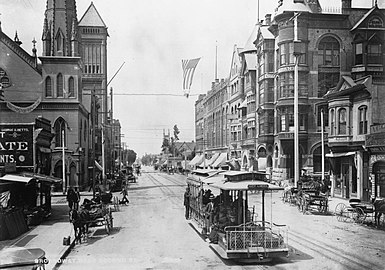


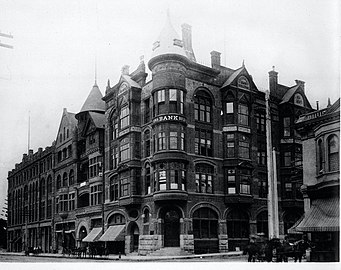



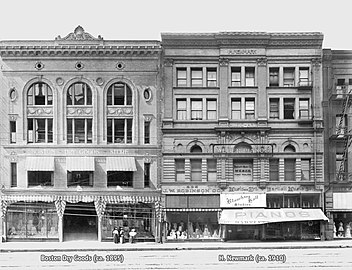
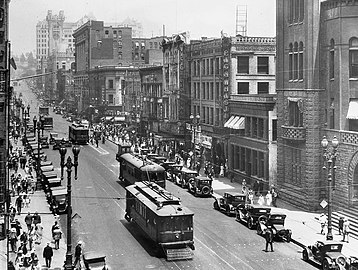






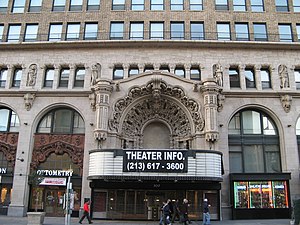



![Bradbury Building in 1894, then anchoring the southwestern end of the business district[47]](http://upload.wikimedia.org/wikipedia/commons/thumb/7/72/Bradbury_Building_1894.jpg/435px-Bradbury_Building_1894.jpg)
